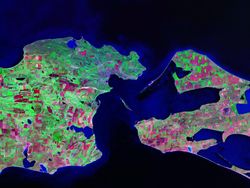Strait of Kerch
- Cimmerian Bosporus redirects here. For the ancient state, see Bosporan Kingdom; for its rulers, see Kings of Cimmerian Bosporus.

The Kerch Strait (Russian: Керченский пролив, Ukrainian: Керченська протока, Crimean Tatar: Keriç boğazı) connects the Black Sea and the Sea of Azov, separating the Kerch Peninsula in the west from the Taman Peninsula in the east. The strait is 4.5 kilometres (2.8 mi) to 15 kilometres (9.3 mi) wide and up to 18 metres (59 ft) deep.
The most important harbor is the Crimean city of Kerch which gives its name to the strait, formerly known as the Cimmerian Bosporus. The Russian side of the strait contains the Taman Bay encircled by the Tuzla Spit to the south and Chushka Spit to the north. The most important settlement on the Russian side is Taman where an important cargo port is under construction.
Contents |
History

The straits are about 5 kilometres (3.1 mi) long and 4 kilometres (2.5 mi) broad at the narrowest, and are formed by an eastern extension of Crimea (Taurica, in ancient times) and the peninsula of Taman, a kind of continuation of the Caucasus. This in ancient times seems to have formed a group of islands intersected by arms of the Kuban River (Hypanis) and various sounds now silted up. The straits were called the Cimmerian Bosporus because of the similarity to the Bosporus straits between the Aegean Sea and the Black Sea, and after the Cimmerians the equestrian nomads on the steppes north of the Black Sea.[1]
During the Second World War, the Kerch Peninsula was the scene of much desperate combat between forces of the Soviet Red Army and Germany. Fighting frequency intensified in the coldest months of year when the strait froze over, allowing the movement of troops over the ice.[2]
Hitler demanded a three-mile road and rail bridge across the Strait of Kerch in the spring of 1943 to support a push through the Caucasus to Persia, although the Cable Railway (aerial tramway) which went into operation on July 14 with a daily capacity of one thousand tons was adequate for the defensive needs of the Seventeenth Army in the Kuban bridgehead. Because of frequent earth tremors, vast quantities of extra-strength girders of precious steel would be required, and their transport would curtail shipments of military material to the Crimea. Hitler's bridgehead on the continent of Asia was evacuated in September [3].
In 1944, the Soviets built a "provisional" railway bridge across the strait. Construction made use of supplies captured from the Germans. The bridge was completed in November 1944, but was destroyed by moving ice floes in February 1945; reconstruction was not attempted.[4]

Ferry and bridge transportation
After the war, ferry transportation across the strait was established in 1952, connecting Crimea and the Krasnodar Krai (Port Krym - Port Kavkaz line). Originally there were four train-ferry ships; later three car-ferry ships were added. Train transportation continued for almost 40 years. The aging train-ferries became obsolete in the late 1980s and were removed from service. In the autumn of 2004, new ships were delivered as replacements and train transportation was re-established.
Moscow mayor Yuri Luzhkov campaigned for a highway bridge to be constructed across the strait. Since 1944, various bridge projects to span the strait have been proposed or attempted, always hampered by the difficult geologic and geographic configuration of the area. Construction of an approach was actually started in 2003, provoking the Tuzla Island conflict. [5]
Fishing

Several fish-processing plants are located on the Crimean coast of the strait. Fishing season begins in late autumn and lasts for 2-3 months, when many seiners put out into the strait to fish. The Taman Bay is a major fishing ground, with many fishing villages scattered along the coast.
Volganeft-139 oil spill
On Sunday 11 November 2007, news agencies reported a very strong storm on the Black Sea. Four ships sank, six ran aground on a sandbank and two tankers were damaged, causing a major oil spill and the death of 23 sailors.[6].
The Russian-flagged oil tanker, Volganeft-139, encountered trouble in the Kerch Strait where it sought shelter from the above storm.[7] During the storm the tanker split the tanker in half, releasing more than 2000 tonnes of fuel oil. It is thought that the effects of the spill are likely to be felt for many years to come. Four other boats sank in the storm, resulting in the release of sulphur cargo. Efforts to rescue crew members were hampered by the storm.[8][9]
References
- ↑ Anthon, Charles (1872) "Cimmerii" A Classical Dictionary: Containing an Account of the Principal Proper Names Mentioned in Ancient Authos (4th ed.) p. 349-350
- ↑ Command Magazine, Hitler's Army: The Evolution and Structure of German Forces, Da Capo Press (2003), ISBN 0306812606, 9780306812606, p. 264
- ↑ Inside the Third Reich by Albert Speer, Chapter 19 (1969, English translation 1970)
- ↑ Bridge across the strait (Russian)
- ↑ The Columbia Encyclopedia, Sixth Edition
- ↑ (French) Marée noire: plus de 33.000 t de déchets pétroliers ramassés sur les plages du détroit de Kertch, 11/28/2007
- ↑ Chris Baldwin (Monday, 12 November 2007). "Russia Tries to Contain Oil Spill, Save Seamen". Reuters. http://www.reuters.com/article/latestCrisis/idUSL12303712. Retrieved 23 May 2010.
- ↑ "Fuel spill disaster reported in waters near Russia". CNN. Sunday, 11 November 2007. http://www.cnn.com/2007/WORLD/europe/11/11/russia.spill/index.html. Retrieved 23 May 2010.
- ↑ Arkady Irshenko (Sunday, 11 November 2007). "Russian oil tanker splits in half". BBC News. http://news.bbc.co.uk/2/hi/europe/7089317.stm. Retrieved 23 May 2010.
![]() This article incorporates text from a publication now in the public domain: Chisholm, Hugh, ed (1911). Encyclopædia Britannica (Eleventh ed.). Cambridge University Press.
This article incorporates text from a publication now in the public domain: Chisholm, Hugh, ed (1911). Encyclopædia Britannica (Eleventh ed.). Cambridge University Press.